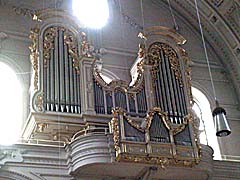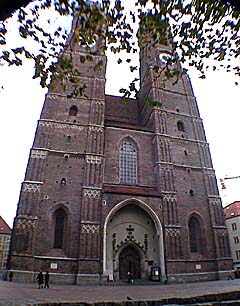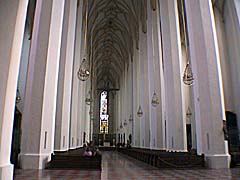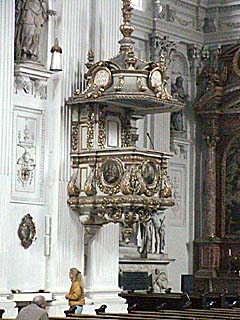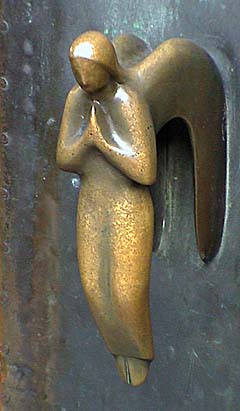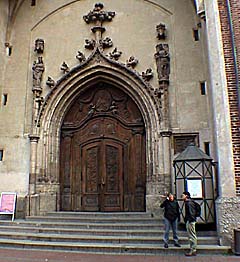
Week 5, part 10
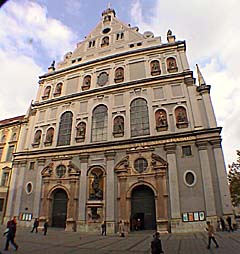 The exterior of St Michael's church in Munich.
One of the sculptures on the outside of the church is this one of St. Michael slaying a demon.
Unfortunately, the pipe organ of St. Michael's was seen and not heard.
The twin towers of Dom were too high to properly fit in the frame.
The interior of Dom.
|
After all of this, we probably should say something about Munich itself. Like London and Paris, we found this to be a very international city, as we saw evidence of visitors from around the world. The first thing we noticed coming out of the Bahnhof was the Strassebahn (tram) shuttling people about, and the bike lanes that occupied their own exclusive space between the street and the sidewalk. The Bahnhof and the Rathaus are connected by a wide pedestrian zone nearly a mile long and branching out in several directions. Late Sunday afternoon the locked store entrances were occupied by buskers. We saw a woman playing wine glasses, a traditional Tibetan group, and a group playing the local oom-pah music. The travel writer Rick Steves described Munich as having a "bombed out" feeling, and we could see what he meant. About 80% of the buildings in central Munich looked like they'd been built since the second World War, but a lot of the stuff that got missed by allied bombs (or repaired since) was spectacular. As in the rest of Europe, religious people will find no shortage of incredible places to pray while secular folks admire the artwork. Two churches in central Munich stand out. St. Michael's was adorned by ornate sculptures inside and out, and its outward appearance was deceptively compact given its cavernous interior. Prominent on the Munich skyline are the twin "onion-topped" steeples of Dom. This church is made of standard red brick, and evidence of post-war repair work can be seen from the outside. The inside was beautifully ornate. The highlight of our visit to central Munich was the Rathaus, which may have displaced the one in Philadelphia as our favorite in the world. Every square inch of the exterior seemed to be decorated with some sort of artwork (mostly sculpture), and the passageway to the central courtyard conformed to the theme. The crowning jewel of the Munich Rathaus is the Glockenspiel on the tower. These are painted figures that start dancing around at appointed times, sort of like 18th- or 19th-century animatronics. Between Switzerland and Munich, it will be hard to choose pictures to accompany this text on our web site ... there are so many good ones to choose from. It's probably more accurate to say that it will be hard to leave any of them out. As the week 5 update comes to a close, we write from our pension in Prague on Thursday, 8 November. We have not been online since last Monday, 5 November, so we haven't had a chance to see whether our week 4 update actually got out or not. Earthlink has no access numbers in Eastern Europe, and cyber cafes seem to be in short supply. Hopefully you'll all get to read this before we get home at the end of the month. Even though electronic communication has been a ... er ... a challenge, we are having incredible amounts of fun. We hope you all are having as much fun as we are, in whatever you do. Take care, and next week we'll tell you all about Salzburg, Prague, and Obbie's ancesteral homeland around Ostrava.
|
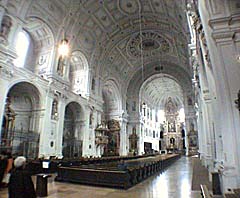 The interior of St. Michael's in Munich.
The pulpit of St. Michael's.
This is the door handle on the entrance to St. Michael's.
A closer view of the entrance to Dom.
|
Week 6 brings us to Salzburg, Prague, and Vitkovice Ostrava.
Previous page
week 5 index
purplearth 2001 europe oddyzee index
purplearth home

